Your outdoor garden doesn’t have to be the only place where you can grow items to use in your kitchen! We’ve put together a list of our eight favorite herbs you can successfully grow indoors all year long!
Do you like to spend as much time in the kitchen as you do in the garden? Then you know what an advantage using freshly-picked herbs in your dishes can make.
From livening up a dish of pasta to adding some zing to your morning omelet, herbs take cooking to a whole new level! Many of the herbs listed below will keep on producing as you harvest them, too.
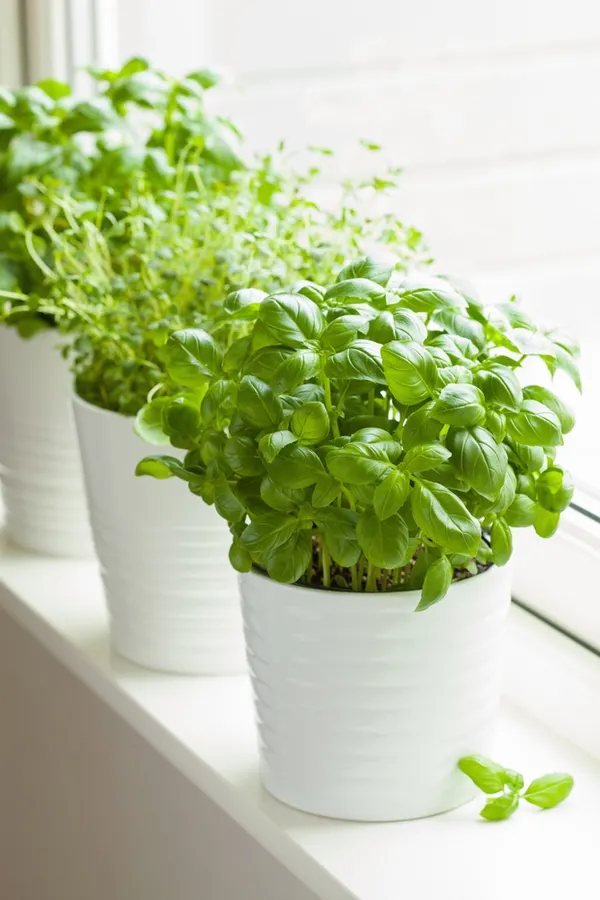
If you’ve been growing herbs in your garden or your cold frame, most herbs can be re-potted and brought indoors during the winter months. (If you’d like to see more information about growing crops in cold frames, check out this article on Using A Cold Frame.)
The best part about growing herbs indoors is that it is easy to do! Most require very little maintenance once they become established, so even the most novice gardener will have success. Consider adding any one (or more!) of these amazing herbs to your window sill and to your dishes!
Grow Herbs Indoors – The 8 BEST Herbs!
Basil
Basil is an extremely versatile herb that is also one of the easiest to grow. You will often see it featured in Italian cuisine. Pasta sauces, classic pesto, soups, or even pizza often include basil. There are over 60 varieties available, each with its own distinct flavor profile.
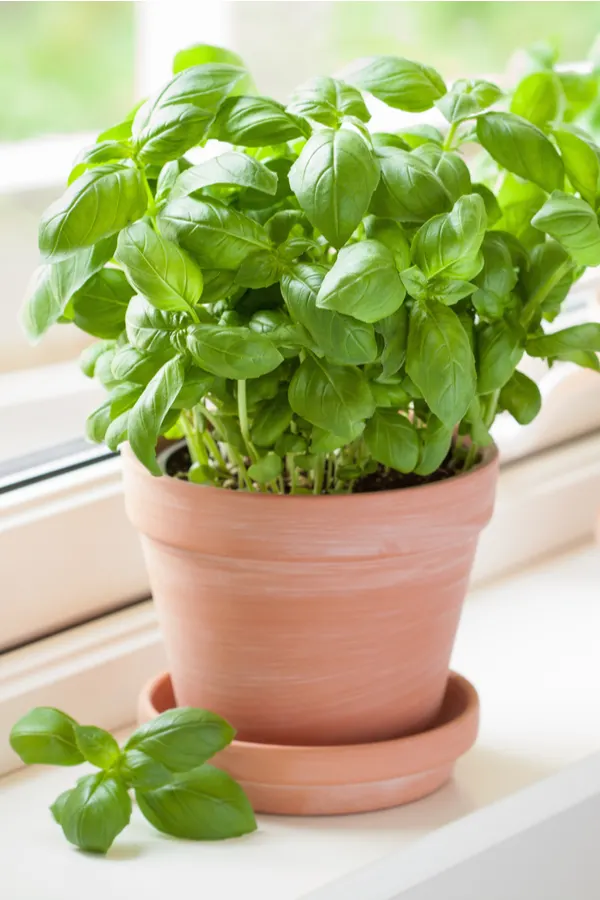
Planting
Plant seeds at a depth of ½” deep into loose and pre-moistened, well-draining potting soil. Keep soil moist but not saturated. You can mist leaves between waterings if needed. Germination should take around 5-10 days. Keep the basil in a location that is around 70-75º F (21-24ºC), and avoid cold, drafty areas. Place in a south-facing window that allows for at least four hours of sun a day. Thin so you have just a couple of seedlings per pot.
Harvesting
Once the plant is around six inches tall, you can start to harvest leaves from the top of the plant. You can pinch off leaves where they attach to the stems or you can harvest full stems. Aim for harvesting ⅓ of the plant every few weeks, pinching off the flowers before they bloom.
Chives
Chives are a member of the allium family. They feature long, green hollow stems and have a mild onion flavor. Chives can be chopped and used as a garnish in dishes like soups, omelets, dressings, dips, or any dish that can benefit from a mild onion flavor. Their purple blossoms are also edible and feature a more garlicky flavor.
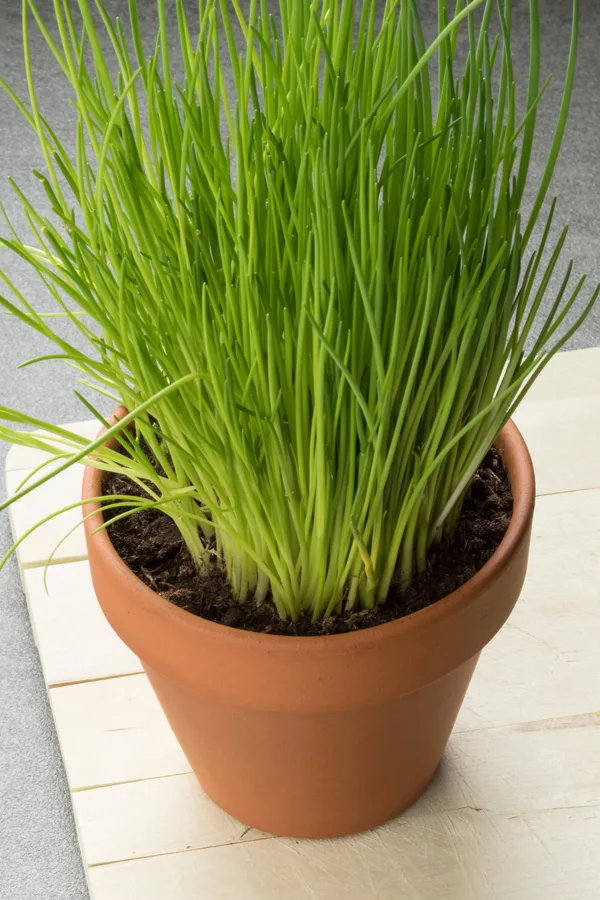
Planting
Fill your container with pre-moistened, well-draining potting soil. Place about 10-15 seeds ¼” deep and cover them with a thin layer of soil. Keep the soil moist and seeds will start to germinate after about two weeks. Place your chives in a south-facing window so they can get around 6-8 hours of full sunlight. Make sure to rotate the plant to keep the stems from leaning toward the sun source. Water when the top surface of the soil is dry. Thin seeds when they are a few inches tall, leaving only the strongest stems behind.
Harvesting
Harvest when the plant is around six inches high, only taking what you need. Cut stems off a couple of inches above the base with sharp scissors. You can keep the cut chives in a plastic bag in your refrigerator for up to one week.
Cilantro
Cilantro is one of those herbs that people typically either love or hate. For those who love cilantro, it’s a great addition to your indoor herb garden. It has a bright and peppery flavor that works well in spicy recipes. Cilantro is used in Middle Eastern, Mexican, Indian, and Asian dishes. It is often added to sauces, salsas, and stir-fried dishes.
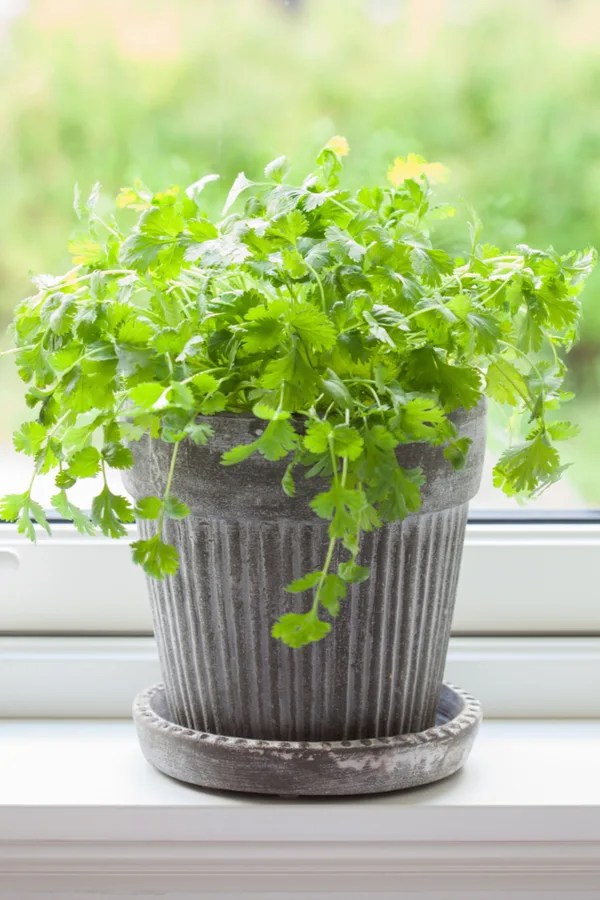
Planting
Use pre-moistened potting soil combined with sand and perlite to aid in water drainage. Plant seeds ¼” deep and lightly cover with soil. Keep the soil moist but not saturated. Place in a South-facing window that receives full sun. Cilantro grows best in areas with temperatures around 70º F (21º C). Thin seedlings so they are 3-4″ apart.
Harvesting
Cilantro will be ready for harvest in about 3-4 weeks. It is best to pinch cilantro plants off at the top to force the plant to be bushier. Only harvest what you will use and use right away since it will wilt quickly after cutting.
Mint
Mint is one of the more simple herbs to grow indoors. It is often used in beverages like tea, mojitos, or hot chocolate. It can also be used in ice cream, fresh summer salads, or other dishes that benefit from a minty flavor. Mint is grown indoors all year long. It does tend to crowd out other plants, so make sure to keep mint in its own container.
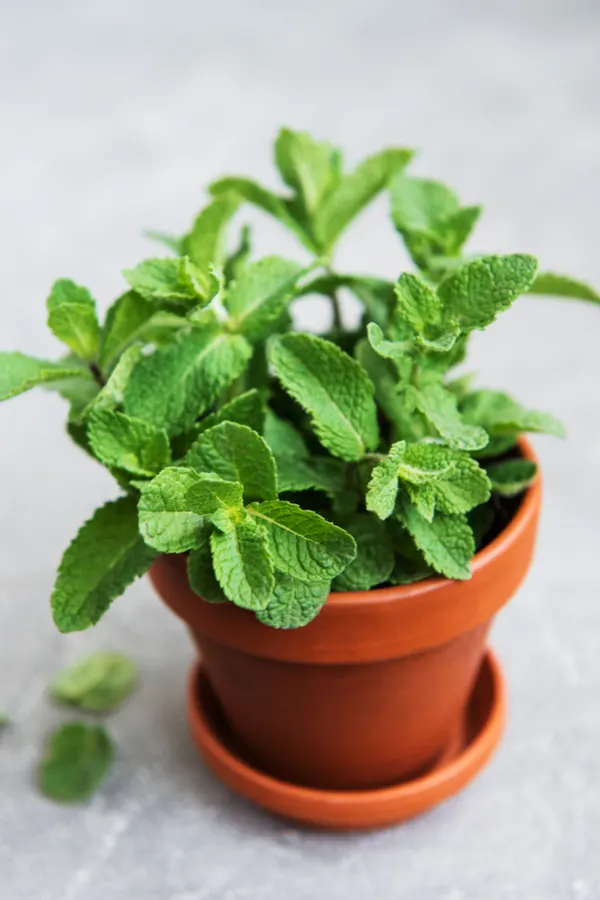
Planting
Choose a pre-moistened, well-draining potting soil that has a good mixture of peat, perlite, and sand. Place seeds on top of the soil. Do not cover with soil since the seeds need light to germinate. Sprouting should occur within 10 to 15 days when temperatures are around 68-75º F (20-24º C). Place in a window that receives indirect light. Keep soil moist but not saturated.
Harvesting
Mint leaves can be harvested at any point. You can also pinch off the top couple of leaves to keep the herb bushier. If you want a bigger harvest, wait until the plant is almost ready to bloom, then trim the plant back to the first or second set of leaves.
Oregano
Oregano is a great perennial herb to grow indoors if you tend to forget watering. Since it is drought-resistant, the soil can become dried out without really harming the plant. Oregano, often called “pot marjoram,” is used often in the Mediterranean, Italian, and Mexican cuisine and features a strong, warm flavor. Oregano should be replanted every couple of years.
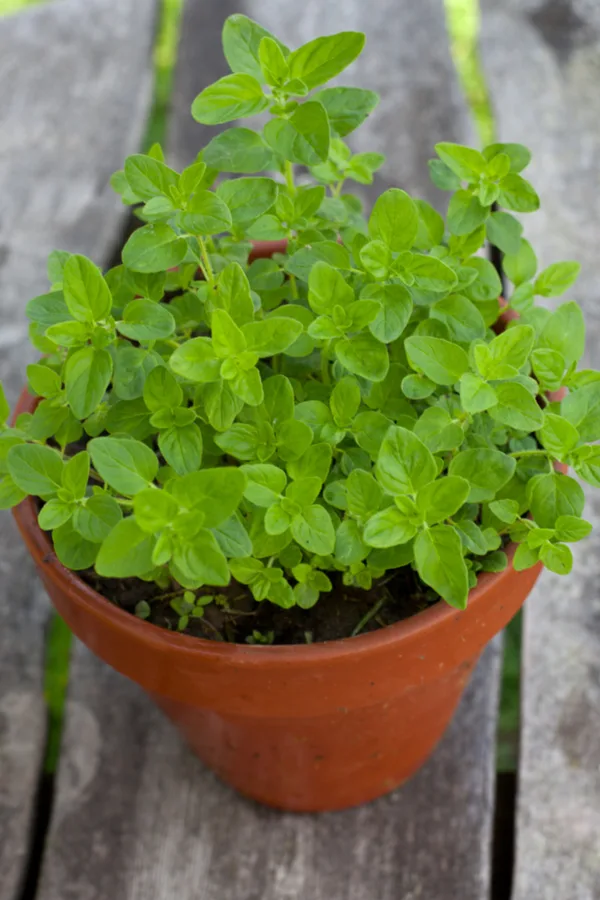
Planting
Place seeds in a pre-moistened potting mix that is well-draining. Water lightly until germination. Germination should take around 5-10 days. Oregano prefers a dryer soil, so allow the top inch or so to dry between waterings. Keep in a warm and sunny location like a bright South-facing window or under fluorescent lights.
Harvesting
Harvest oregano often during the growing season to prevent early flowering. Simply pinch off the leaves that you need for your dishes. Consider pinching off leaves early in growth to promote a bushier plant. When your plant is around six weeks old, cut back to around an inch tall.
Parsley
Parsley is one of the most commonly used herbs that you can grow indoors. It is actually a member of the carrot family and is often used as a garnish. When used in dishes, it offers a mild flavor and is high in antioxidants, vitamin A, and vitamin C.
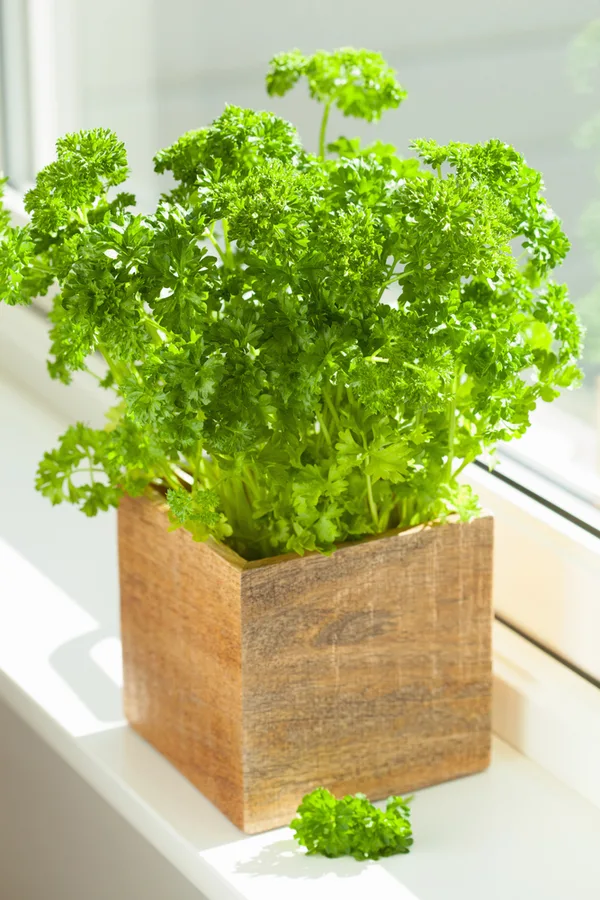
Planting
Using a pre-moistened potting mix, scatter seeds into the container. Cover with ¼” of soil and water if needed. Keep soil moist but not saturated. They are very slow to germinate, taking around 14-30 days. You can help speed this process along by soaking seeds overnight prior to planting. Parsley requires full sunlight with at least 5-8 hours each day in order to thrive. A South-facing window works great. Once germinated, thin so plants have around 6 inches between them.
Harvesting
Parsley should be harvested often, especially before it blooms. Start with the other leaves and work toward the center of the plant. Harvesting frequently helps encourage additional growth. You can simply snip or pinch off a few sprigs. Use cut herbs immediately or place in a glass of water and refrigerate.
Sage
Sage is an evergreen shrub that adds a warm, earthy flavor to savory dishes. You may even associate it with your Thanksgiving dinner because it is often used in holiday dishes like stuffing. It works well with cheeses, bread, fish, and meat. For a delicious homemade stuffing recipe using sage, check out this Slow Cooker Thanksgiving Stuffing recipe.
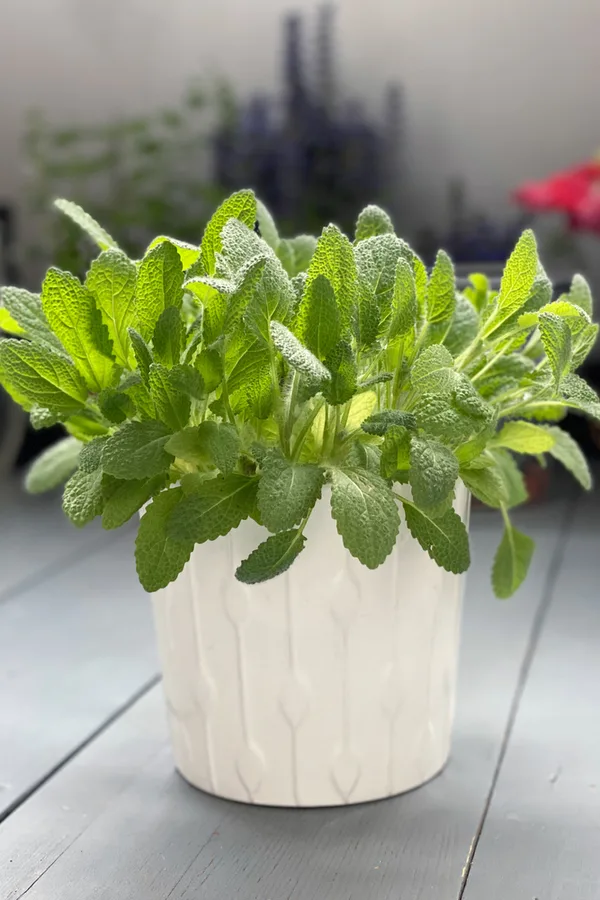
Planting
Place seeds in a pre-moistened, well-draining potting soil mix, or you can even use cactus soil. Place in a location with full sun, such as a South-facing window. The seeds should germinate in 10-21 days. Once seeds have germinated, allow the top of the soil to dry out before watering.
Harvesting
It will likely take around 75 days from planting seeds before harvesting. Entire stems can be cut or you can pinch off individual leaves. Make sure to harvest before the sage flowers for the best flavor. Your sage plant will need to be replaced every few years.
Thyme
Thyme is a popular herb that is used in many different cuisines but especially in meat, vegetables, or fish dishes. It also goes well in savory baking or in soups and teas. Thyme adds a woodsy, grassy, or floral note to dishes. It can be used de-stemmed or added to the dish whole to impart flavor. If thyme is used whole, it needs to be removed since the stems are not able to be broken down when cooked.
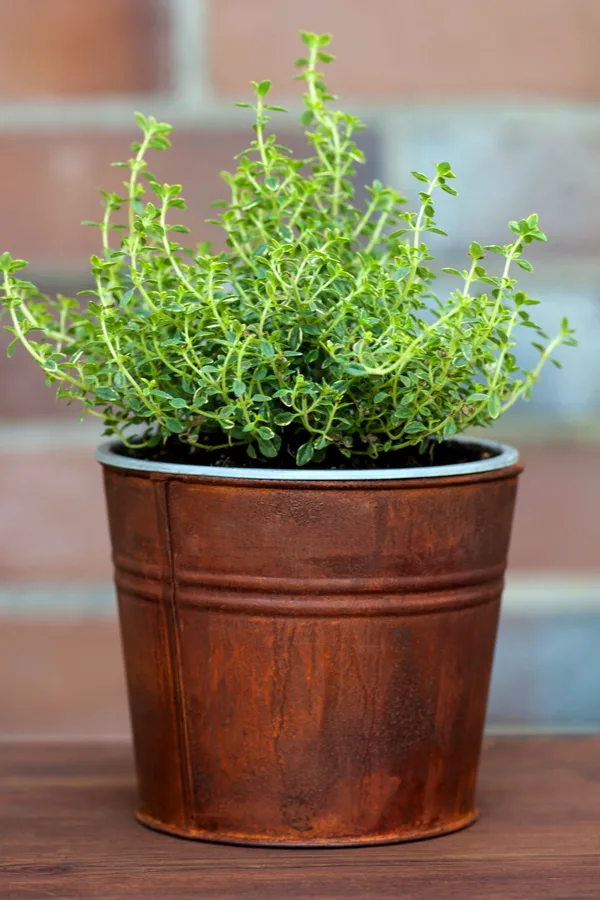
Planting
Choose a potting soil that has a great combination of soil, peat moss, perlite, and sand to help promote drainage. Place seeds in a pot and lightly cover with soil. Place the pot in a location with full sun or at least 6 hours of indirect sunlight. Keep moist until germination. Germination is a bit slower than other herbs, taking around 14 to 28 days when temperatures are at least 70º F.
Harvesting
You can harvest thyme right before the plant flowers. Cut off the top 5-6 inches of stems, leaving the woody base. You should be able to harvest thyme multiple times during the growing season. Don’t allow it to get leggy.
To Conclude…
If you’re looking for one more fantastic herb to grow indoors through the winter, be sure to check out our article: The Secrets To Growing Rosemary Indoors – Grow Fresh Rosemary As A Houseplant!
Not only is using fresh herbs a great way to amp up your culinary dishes, but it’s also a great way to allow you to practice your green thumb no matter what the temperatures are outside! When you grow any one of these 8 great herbs indoors, you can enjoy fresh flavors in your dishes all year round!
